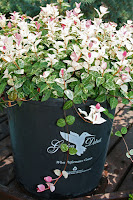Color is one of the most compelling of plant attributes and attracts attention in any landscape. Traditionally, color in gardens is supplied by flowers. With bedding plants this color is reasonably reliable, but when perennial flowers are used, they have distinct and limited bloom-periods. The best way to prolong landscape color indefinitely is through the use of plants with colorful foliage.
·
Colored
foliage ranges from white to near-black burgundy, with all the hues in between.
·
Colored
leaves often thrive in more shade that plants that rely on flowers, extending
the range and bringing color options into darker landscape areas.
·
Variegated
foliage is another version of landscape color and incredible patterns and
combinations attract garden interest.
Two of the most commonly used colored-leaf foliage plants spring to mind:
Caladium
or Caladium bicolor grow from a tuber
or enlarged underground stem and produce medium-sized (6 to 24 inches), heart-shaped leaves of white, pink or red with
myriad variegation. Tropical caladiums are useful in
shade and are grown by many gardeners for this distinct foliage. Selections are predominantly red, pink or white. Native to South America, caladiums will not survive cold winters that experience heavy frost.
Perennials with colored foliage are also indispensible
Varieties of Heuchera or Coral Bells have been bred to produce a rainbow of colors from nearly black ‘Obsidian’ to bright pink ‘Georgia Peach.’ Heuchera are wonderful grouped in beds or added to container plantings.
 |
| Snow-N-Summer fills pot |
For more ideas on using colorful foliage to light up the landscape, visit Garden Debut(R).














.jpg)
